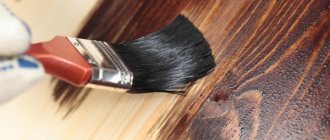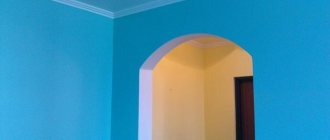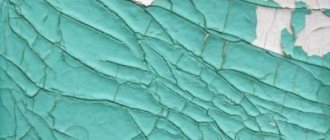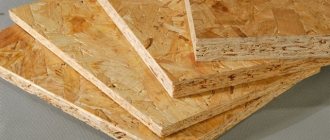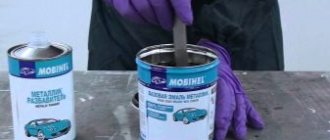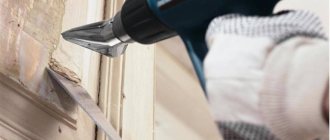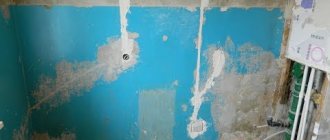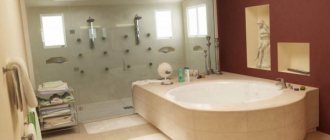What type of varnish is applied to painted wood?
Varnish can be used to protect, preserve and improve the quality of paint. With all the modern advances in coatings—polyurethane, shellac, urethane or varnish—some confusion with the formula is to be expected. Most professionals agree that water-based varnish is the best product for applying paint.
Water based formula
Varnish is more durable than paint and adds shine to painted surfaces. When applied over previously painted handrails, furniture, steps or other woodworking objects, varnish forms a protective layer that allows the paint to show through. Most clear products turn yellow over time, due in part to oil-based formulations that contain volatile organic compounds. Products containing VOCs are considered hazardous to health. Water-based varnish contains no VOCs and does not yellow like oil-based products. Water-based varnish is also sometimes called water-based urethane, although the products may have slightly different formulas. They both perform the same duties.
Surface preparation
To obtain a smooth coat of varnish, the base paint surface must be clean and smooth. If the surface is dirty or dirty, wash it off with a soapy sponge and let it dry. Preparation should also include lightly sanding the painted surface with 100-grit sandpaper to roughen it so the varnish will adhere better. If you see flaking paint, use a wire brush to remove loose particles and then continue sanding until the surface is smooth to the touch. Paint removal is not necessary unless it is flaking or loose. If a wire brush doesn't remove it, don't force it.
Primers
Varnish will not adhere properly to oil paint without first adding a primer. If you are dealing with an old painted surface, the paint is often oil-based. To determine if paint is oil-based, test it by rubbing a small area with a cotton swab soaked in alcohol. If the paint is rubbing off, it's probably oil-based and requires a water-based primer before applying varnish. If you can't tell whether you're dealing with oil-based or water-based paint, just apply primer either way. Adding a primer over water-based paint won't hurt.
Gloss
Choose your gloss wisely. Gloss varnish is exactly what it sounds like. This adds a glossy shine to painted woodwork. Use it for a modern look. The medium sheen polish has some shine, but not enough to attract attention. Gloss or satin finishes are intended to preserve older paint looks or for a more antique finish.
Spray or brush
A smooth finish can be achieved with a brush if you are experienced, but the best finishes are usually applied. For most small jobs, a water-based aerosol can will work. Hold the jar about 8 inches from the surface at an angle of about 30 degrees. Spray overlapping strips of varnish to lightly cover the surface. Once dry, lightly sand the surface with 220-grit sandpaper. If the surface is cut out, detailed, or has sharp corners that sandpaper cannot reach, use fine-grit steel wool. Be careful when sanding corners and edges; It is easy to sand the paint in these areas. Add three more coats for deeper shine and better protection.
,
Classification of varnishes by purpose
Varnishes are used primarily for treating wooden surfaces, but they can be used to treat products and substrates after painting - brick, concrete, plaster. Compositions are divided into several broad groups depending on their purpose:
- For processing furniture and surfaces made of natural wood. Varnish is used for interior work. The composition of the varnishing agent can include coloring pigments for additional tinting of products, or the solutions can be tinted immediately before applying the varnish layer.
- For finishing parquet and parquet flooring. High-density varnishes help protect wooden floors from negative impacts and emphasize the woody texture of the natural material. They are characterized by resistance to abrasion and form a thin film.
- For decorative varnishing of walls indoors and outdoors. Universal products are characterized by acceptable resistance to moisture, ultraviolet radiation and are affordable. Using such products, you can varnish walls painted with various types of paint.
- Highly resistant yacht varnishes. They are advisable to use when treating surfaces and products that are often in contact with a damp environment. Used for finishing window frames on the street side, door frames, garden furniture, gazebos and other wooden structures.
What varnish should I use to protect a product or material? It depends on the surface being treated. Different compositions are intended for finishing wooden, brick or metal surfaces. It is necessary to take into account what kind of paint the base is painted with (water-based or non-water-based), as well as the location of the work - walls, facades, furniture.
On video: the intricacies of varnishing wooden products.
Drawing conclusions
When answering the question of how you can cover a bathtub that has lost its attractive appearance, you can clearly answer that it is not possible to obtain a coating with the original performance data using any of the above methods. All types of coatings allow you to slightly extend the operation until a major overhaul of the premises with the replacement of finishing and equipment. The best way to cover the bathtub at this time depends on the required service life and the material of the bathtub itself. Acrylic bathtubs can only be repaired with acrylic, but when repairing the coating of metal products, you can choose a repair composition.
Sometimes owners ask if it is possible to varnish the bathtub to restore the shine to the dull coating. In this case, it is better to polish the surface until it shines. The varnish can fade, crack and completely ruin the enamel. Silicone bath coating applied directly to enamel is used as a separating layer in thermal or ultrasonic treatment baths in industry. But a replaceable silicone mat for the bottom of the bathtub will protect the enamel from scratches and reduce slipping on a wet surface.
Types of product by composition
On the modern paint and varnish market you can purchase a wide variety of varnishes. Solutions can give a glossy or matte effect, leave a transparent and pigmented layer, and contain craquelure, mother-of-pearl, and glitter. The entire variety of products for varnishing can be divided into several types depending on the composition:
- Water-based acrylic. Safe, environmentally friendly composition. The use of acrylic is suitable for processing wooden surfaces, acrylic plaster and plaster.
- Oil based on natural or synthetic resins and oils. Penetrates deeply into the internal structure of the material, takes a long time to dry, and forms a durable coating.
- Alkyd for exterior use and wood products. It has good moisture resistance and is universal in use. The composition contains alkyd resins and synthetic solvents.
- Polyurethane universal type. Resistant to any type of impact (scratches, moisture, chemicals). Combines with different types of materials and paints.
- Quick drying nitro varnish. It adheres well to the treated surface, but is highly toxic. Capable of dissolving some types of paints.
- Epoxy for rooms with high humidity. It has good strength characteristics, high drying speed and attractive appearance.
In order not to make a mistake with the choice of varnish for different surfaces, you need to choose compositions from the same group. For example, acrylic paint can be coated with acrylic varnish. It is important to take into account that water-based acrylic paints that are not resistant to moisture can be partially washed off.
How to wash walls before renovation
Paint guru➣Varnishes➣Types of varnishes➣
To open the internal or external surface of the walls of a building with varnish means not only to give a certain appearance, but, above all, to provide additional protection to the base materials from the harmful effects of the environment and destruction by time.
The paint and varnish market today offers a large selection of solutions suitable for performing various painting jobs.
Some products are designed for processing products and surfaces made of metal and other materials.
In general, the market is so diverse that even the most demanding client will find a suitable composition to cover the walls inside or outside the house. Lacquered surfaces:
- prevent moisture from penetrating deep into the wall base materials;
- protect from the influence of sunlight (that is, from fading and color fading);
- strengthen the structure of frame materials, preventing destruction under the influence of time;
- provide a certain level of protection from mechanical damage and exposure to chemicals;
- give a decorative look to the finish.
In order to properly varnish the walls, you need to know which solutions should be used in a particular case, as well as how to do it technologically correctly.
When going shopping, you need to understand exactly what properties of varnish you need.
If, for example, you plan to cover the surfaces with varnish in the bathroom, then it should be a coating with high moisture resistance.
And if you plan to paint in a children's room or bedroom, then you need to choose the most non-toxic product. The type of base materials also influences the choice of decorative protective agent.
For indoor work (residential, non-residential, public), water-based solutions are considered the safest. Water-based acrylic composition is very popular, despite the price not suitable for everyone.
Advantages:
- the composition does not include organic solvents, which makes the product environmentally friendly;
- no odor;
- creates a durable and elastic film on the surface;
- in the original acrylic varnish is colorless, transparent, does not turn yellow over time, which does not affect the natural shade of the color of the base materials (especially wood);
- tinting is acceptable;
- by degree of gloss: high-gloss, glossy, semi-gloss, semi-matte, matte;
- non-flammability;
- easy application (brush, roller, spray);
- fast interlayer drying;
- Wide range of applications: for any wooden surfaces (including painted ones), brick and stone masonry, plastics, metal, etc.
Flaws:
- final drying – 24 hours;
- the final polymerization period is too long - up to 2 weeks;
- subject to abrasion during intensive use of premises (on wooden floors).
Not only acrylic varnish is water-based, but also one- and two-component polyurethane. There are many advantages to using it:
- no odor, non-toxic;
- short drying time: 2-3 hours between layers, 8 hours - you can already walk in socks, 3-4 days - calmly bring in furniture;
- uniform, easy application;
- good adhesive properties;
- strength, abrasion resistance, durability;
- chemical resistance;
- versatility of application.
But if you want to varnish the outer brick or wooden wall of the house, then it is better not to use water-based varnish (acrylic or other), since the protection will not last long.
In this case, compositions based on organic solvents, for example, alkyd, are used. A significant disadvantage of such solutions is that the drying period is too long.
But with the addition of special hardeners, this process can be accelerated.
Such varnishes form a durable film that is resistant to various influences, including moisture. Light and heat resistant, easy to apply, almost transparent, and have an attractive appearance.
There are other varnish compositions based on organic solvents:
- nitro varnishes;
- urethane group;
- oil varnishes;
- epoxy;
- bituminous.
Shellacs stand out separately - natural types of varnishes, difficult to obtain, difficult to work with, expensive, but having unique decorative properties.
Basically, consumers require either a mirror gloss or a discreet matte finish. This can be achieved with acrylic or polyurethane varnish. But with the addition of various components, you can give surfaces a completely unique decorative look.
For wooden surfaces, technologies of artificial aging, tinting, and enhancing textural depth are often used. What kind of varnish can you use to open up walls in an unusual way?
- Craquelure varnish - creates an imitation of a naturally aged cracked surface on a plastered wall. The network of cracks is obtained by applying a two-layer crackle varnish with additional patination of the cracks.
- Pearlescent varnish – used as a finishing decorative finish, creates a unique spectral shimmer effect. Produced on an acrylic base. Used to protect and decorate plaster, paintable wallpaper, mineral and wooden surfaces.
- Glitter varnish - available in the form of an acrylic mixture with glitter for finishing surfaces. The decorative additive can be purchased separately in a wide range of colors. Thus, by mixing the components yourself, any painting mixture can be made with glitter.
We suggest you familiarize yourself with Acrylic enamel and acrylic paint - which is better to choose?
Whatever varnish you use to protect wooden and other surfaces inside and outside the house, be sure to adhere to the application technology and technical requirements when working. During the drying period of the varnish, you should also follow some rules.
If you are not sure that you can handle the task yourself, entrust it to professionals. Experts in matters of high-quality repairs and construction will help you select the necessary materials, and will also carry out everything at a high professional level.
If you need to thoroughly wash the walls and ceiling before applying a new coating, you must use the following methods: a strong solution of alkaline detergent, a stiff brush, and thorough rinsing with plenty of water. You must wait until it is completely dry before applying a new coat of paint. If the surface is poorly washed, the new finish will not be of high quality.
Features of MDF varnishing
When finishing furniture and doors, varnish is used to give products a more interesting color and protect them from damage. MDF fiberboards differ from natural wood in structure, so a two-component varnish is suitable for processing them. With its help, it is possible to give products an unusual effect and make the material resistant to temperature and moisture.
Requirements that varnish for coating MDF panels must meet:
- two-component, odorless product;
- moisture resistance and heat resistance;
- high antiseptic characteristics;
- optimal drying time – up to 72 hours;
- operating temperature of use - +5+25°C;
- content of volatile substances within 20%;
- material consumption rate – up to 0.5 kg per 1 m2.
MDF panels can be coated with a synthetic product to achieve a glossy effect, or water-based acrylic varnish can be used to give the surface a matte finish. The coating is applied to the slabs with a brush or spray.
Preparation and varnishing of MDF includes the following steps:
- Before varnishing, a primer is applied to the MDF panels and the damaged areas are treated with putty.
- The product is sanded with fine-grained sandpaper and a second layer of primer is applied.
- They are varnished, difficult areas are treated with a brush, and then the main part of the furniture facade, panel or door is varnished.
Since the varnish for MDF is based on two components, before work they are combined and stirred with a construction mixer, and the mixture must be filtered. The prepared working solution must be used within three hours. Can it be used later? Not recommended.
In what interior will glitter work?
Glitter paints are resistant to dirt and water, making them suitable for finishing rooms with high humidity or with strict sanitary requirements. With their help, it is easy to achieve the effect of pearlescent shine, golden, iridescent or metallic shine.
In the interior, glitter paint is used to highlight an accent wall or part of it, as well as to create transitions between surfaces.
The most successful design solutions:
- for the bedroom - emphasizing the wall or its separate part at the head of the bed;
- in the kitchen - design an apron that will diffuse light;
- in the living room and children's room - decorating a contrasting wall, free of furniture or located behind the sofa;
- coating with glitter is suitable for cornices, columns, building pillars, and openwork walls.
Decorative paint with glitter of the required color range will refresh the interior and place important accents. The assortment includes coatings with pearlescent, hologram, and metallic effects. Silver glitter particles harmonize with the cool shades of the decor. Gold and copper sparkles are chosen to achieve a glamorous effect in warm-toned interiors.
0.4 mm is the average size of decorative glitter for paint and varnish.
Securing gouache with varnish
When performing creative woodworking, creating decorative objects from plaster, painting and decoupage, artistic paints are used. After application, the gouache must be fixed so that the paint layer is resistant to abrasion, cracking and moisture. Some paints under incorrectly chosen varnishes “float” and become smudged. To avoid this, cover the design (ornament, pattern) with acrylic or alkyd paint.
The procedure for working with acrylic varnish:
- Traditionally, gouache varnishing is done using wide synthetic brushes with long bristles. Some artists use aerosols to avoid smudging the gouache.
- The use of a roller, sponge and sponges is appropriate only if it is necessary to obtain a certain decorative effect. Tools for work must be dry and clean.
- Select an effect. The glossy composition gives a pleasant shine, but when exposed to light, the work will reflect glare. Matte varnishing can mute the shades. The output is a semi-matte composition.
- When using a brush, the tool is dipped in varnish and squeezed well on the edge of the container. The varnish is applied with intense strokes. The acrylic composition is white, the treated areas are clearly visible.
- To achieve the desired effect of a varnished surface, several thin layers can be applied, allowing a drying interval of two to three hours.
Some products decorated with artistic painting using gouache are often used in everyday life. How to fix gouache so that the coating lasts longer? It is recommended to perform multi-layer varnishing. To do this, acrylic varnish is applied at least ten times, dried and lightly processed with fine sandpaper.
Some craftsmen use strong-hold hairspray to fix gouache; they use polyurethane compounds, furniture and yacht varnishes. The choice of product also depends on the color saturation of the gouache. Thus, red gouache under nitro varnish will flow, and light paints may acquire a yellowish tint when using alkyd PF compositions.
How to varnish water-based paint?
For interior decoration, water-dispersion and water-based paints are increasingly used. There is no fundamental difference between them, and the only difference is the degree of coverage. To preserve the pleasant color of a surface painted with water-based paint, you can use varnishes. But you need to use formulations with similar characteristics.
Water-based paint comes in different types, so each option requires a separate water-based varnish:
- Water-based acrylic paint requires a preliminary application of acrylic primer and then an acrylic-based water-based paint varnish.
- Silicone-based water-based paint cannot be varnished, since it penetrates deeply into the internal structure of the material.
- Acrylic water-based paint can be treated with medium-viscosity polyurethane varnish. The surface of the walls is easy to clean, the integrity of the coating remains for several years.
- Nitrovarnishes for water-based paint partially dissolve the composition, so they must be used very carefully. In addition, nitro varnishes emit toxins and are best used for outdoor use.
Alkyd varnishes can be used to coat wooden surfaces treated with alkyd enamels. If the wood is painted with water-based acrylic paint, then acrylic varnish is chosen to protect the coating.
The main rule of varnishing technology for various surfaces is that paint and varnish compositions must be included in the same group, that is, have the same characteristics of substances at the molecular level. The use of varnish has both a decorative and protective function, extending the life of products, objects and surfaces.
Master classes on varnishing (2 videos)
Different types of varnishes (30 photos)
How to wash off soot and grease
The task becomes more complicated if grease or soot has accumulated on the water-based paint, which often happens with kitchen walls. In such cases, you need to use more effective means. A home method is suitable: a solution of soda (3 tablespoons per bucket of water), applied to the stain and left for 20-30 minutes, not until completely dry.
After this, the dirt can be easily washed off with a regular sponge. With the same success, you can use table salt to wash the walls if there is no soda in the house. To wipe walls coated with water-based paint, it is better to use a soft cotton cloth. You can also wipe such surfaces with a mild soap solution.

